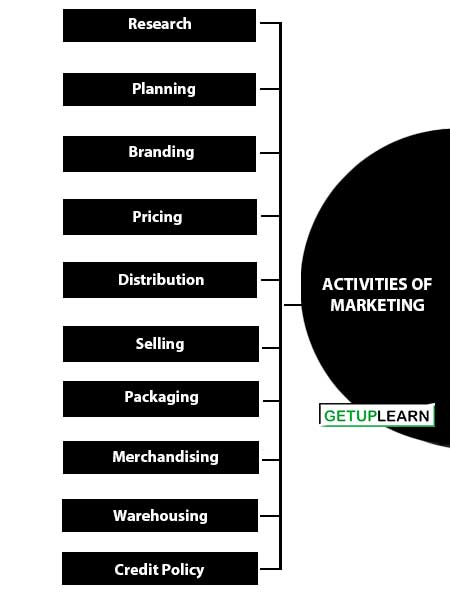Table of Contents
Activities of Marketing
People generally confuse marketing with sales. However, sales are only one of the activities of marketing. Marketing encompasses the following activities:
- Research
- Planning
- Branding
- Pricing
- Distribution
- Selling
- Packaging
- Merchandising
- Warehousing
- Credit Policy

Research
This should be a continuous activity throughout the existence of the SSI unit. It begins with a marketing survey to establish the demand and supply position in order to determine the feasibility of setting up a unit for the manufacture of a particular product. Once the feasibility is established, research is required to identify the customer needs that remain unsatisfied, and to show how the intended product can be modified or designed to meet those unfulfilled needs.
In short, one has to see the product as the customer sees it, and ‘customer satisfaction’ must be the main criteria for evaluation of all proposals and actions. Even after the unit has commenced production, research on how to improve the product, reduce cost, packaging, distribution, etc., to increase the market must continue.
Planning
This activity starts at the proposal stage and is essential throughout the life of the unit. At the proposal stage, this would include activities such as planning, market development, decisions about packaging, setting up distribution networks, warehousing, and short-term and long-term sales planning.
After the unit goes into production it will include sales planning. A sales plan should include a forecast of sales for the future, a plan for territorial coverage, a program to achieve projected sales, and a sales promotion plan if required.
Branding
Branding is absolutely essential for consumer products as well as consumer durables and industrial products. This is because the same product is available from different manufacturers with widely diverse qualities. Besides, it helps the manufacturer, retailer, and consumer in the following ways:
- It enables effective and easy identification of the product of a particular manufacturer by consumers.
- The manufacturer benefits from this since the consumer asks for his specific brand.
- It enables the manufacturer to have better control over sale outlets and the price of the product.
- If the brand is popular it benefits the retailer by attracting consumers to his sales outlet thus helping him sell other products as well.
Pricing
Price is usually associated with value, status, quality, and durability. The point to remember is that a customer is more sensitive to price when the frequency of purchase is high or when the quality of competing products/ brands is more or less the same. Examples of this are hardware, matches, gums, stationery, chemicals, petroleum products, etc.
However, where a customer detects quality variations between brands, the price becomes immaterial. Examples of these would be razor blades, toilet soaps, cars, machinery, etc.
There are five different methods that can be employed in pricing a product; in line with similar products already in the market, slightly higher than the price leader in the market, slightly lower than the price leader in the market, on a cost-plus basis, or on the basis of profit yield at different sales levels. Attempts at answering these questions will help the entrepreneurs in price fixing.
Distribution
The objective of a distribution network is to make the product conveniently available to the largest number of customers in required quantities, where and when they are needed.
This can be achieved through agents, stockists, wholesalers, distributors, manufacturers’ own shops, retailers, street vendors, and mail-order catalogs. The selection of sale outlets will depend on the nature of the product, the number of consumers, and the financial resources available.
Selling
A sale can be described as ‘converting goods into cash’. Most people confuse a sale with the booking of an order, however, no sale is complete till the goods have been delivered and their value recovered. This must be kept in mind while assessing the performance of your own sales staff and also while finalizing terms with agents, distributors, etc.
Packaging
Packaging is essential to hold the product, to protect the product, and to attract customers. Besides keeping these aims in mind, one must also look into the costs when selecting the kind of packaging to be used.
Merchandising
Merchandising is the art of displaying your products at the point of sale so as to catch the consumer’s attention, highlighting the plus points of the product, and enticing the consumer to buy it. This is mainly applicable in the case of consumer goods and consumer durable.
Display, windows, attractive and eye-catching displays of products on shelves and sales counters, hoarding, and billboards outside the sales outlet are some of the methods used in merchanding.
Warehousing
Warehousing is considered necessary to store goods and thus protect them from theft, weather, rodents insects, etc. While these reasons for warehousing are certainly relevant, there are other equally important reasons such as the following: Where high consumers are located both inside and outside octroi limits and the manufacturer is himself outside these limits, storage of products outside these limits results in savings.
- Where high local sales tax is prevalent in one state and the manufacturer is located in another state, warehousing in the state where the manufacturer is located and selling in the other state results in savings.
- Where transit time is long and consumers are most likely to wait for extended delivery periods, warehousing of goods in proximity to the market will yield increased sales.
- Where storage costs at the location of the unit are high and warehousing at lower costs is possible in a place near consumers, savings in money can be affected.
- Where excise duties on the product are high and a substantial stock has to be maintained, operating excise-bounded warehousing can result in saving in terms of interest on the duty value for the duration of storage.
Credit Policy
Many products can be in a buyer’s market in the sense that there would be a number of manufacturers/sellers of those products. With such competition, customers demand special services. The purchasing power may be in the form of cash or credit. Often a customer is not willing to invest in full or in part at the time of purchase.
This may be due to a lack of funds or unwillingness to take a risk with a new product. If an entrepreneur wants to develop his business, he should be able to provide credit facilities to his customers. The credit facility builds the confidence of a customer in a new product or a new company.
FAQs Section about the Activities of Marketing
What are the activities of marketing?
The following are the activities of marketing:
1. Research
2. Planning
3. Branding
4. Pricing
5. Distribution
6. Selling
7. Packaging
8. Merchandising
9. Warehousing
10. Credit Policy.

